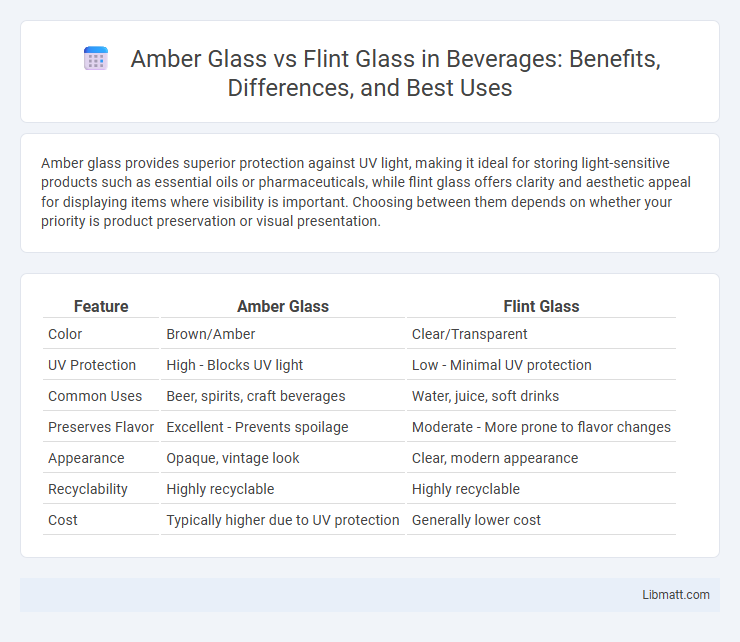Amber glass provides superior protection against UV light, making it ideal for storing light-sensitive products such as essential oils or pharmaceuticals, while flint glass offers clarity and aesthetic appeal for displaying items where visibility is important. Choosing between them depends on whether your priority is product preservation or visual presentation.
Table of Comparison
| Feature | Amber Glass | Flint Glass |
|---|---|---|
| Color | Brown/Amber | Clear/Transparent |
| UV Protection | High - Blocks UV light | Low - Minimal UV protection |
| Common Uses | Beer, spirits, craft beverages | Water, juice, soft drinks |
| Preserves Flavor | Excellent - Prevents spoilage | Moderate - More prone to flavor changes |
| Appearance | Opaque, vintage look | Clear, modern appearance |
| Recyclability | Highly recyclable | Highly recyclable |
| Cost | Typically higher due to UV protection | Generally lower cost |
Introduction to Amber Glass and Flint Glass
Amber glass offers superior UV protection, making it ideal for preserving the quality of light-sensitive products such as pharmaceuticals and beverages. Flint glass, also known as clear glass, provides high clarity and transparency, perfect for showcasing the contents inside while maintaining durability. Your choice between amber and flint glass depends on whether you prioritize UV protection or visual appeal for your packaging needs.
Key Differences: Amber Glass vs Flint Glass
Amber glass offers superior UV protection, making it ideal for preserving light-sensitive products, whereas flint glass is clear and provides no such protection. Amber glass is commonly used for pharmaceuticals and beverages requiring extended shelf life, while flint glass is favored for its clarity in applications like decorative bottles and optical uses. Choosing between amber and flint glass depends on your need for light protection versus aesthetic transparency.
Chemical Composition and Properties
Amber glass contains iron, sulfur, and carbon compounds that absorb UV light, providing superior protection against sunlight, making it ideal for packaging sensitive products such as pharmaceuticals and beer. Flint glass, made primarily from pure silica and soda-lime, offers high clarity and transparency but lacks UV filtering capabilities, which limits its use in applications requiring light protection. The chemical additives in amber glass enhance durability and resistance to chemical corrosion, whereas flint glass remains more chemically inert but susceptible to light-induced degradation.
Light Protection: UV Resistance Compared
Amber glass offers superior UV resistance compared to flint glass, effectively blocking harmful ultraviolet rays to protect light-sensitive contents such as pharmaceuticals, essential oils, and beverages. Flint glass, being clear and colorless, allows more UV light to pass through, making it less suitable for products requiring extended shelf life and protection from photodegradation. Choosing amber glass ensures your products maintain potency and quality by minimizing UV exposure.
Common Uses and Applications
Amber glass is widely used in the pharmaceutical and beverage industries due to its excellent UV protection, preserving the integrity of sensitive liquids such as medicines, essential oils, and beer. Flint glass, known for its clarity and high light transmission, is commonly used in display packaging, decorative bottles, and laboratory glassware where visibility of the contents is critical. Both types of glass find important roles in packaging, with amber glass providing protection against light-induced degradation and flint glass offering aesthetic appeal and content visibility.
Environmental Impact and Recyclability
Amber glass offers superior protection against UV light, which can extend the shelf life of products and reduce waste, contributing positively to environmental sustainability. Both amber and flint glass are highly recyclable, but amber glass is often preferred in the recycling stream for its ability to be remelted multiple times without significant quality loss. The widespread recycling infrastructure for flint glass supports efficient reuse, yet the environmental impact of production favors amber glass due to its energy-saving properties in product preservation.
Strength and Durability Comparison
Amber glass offers superior strength and durability compared to flint glass due to its thicker composition and added iron content, which enhances its resistance to breakage. Flint glass, while clear and aesthetically pleasing, is more prone to chipping and cracking under stress. Choosing amber glass for your containers ensures better protection and longer lifespan in demanding environments.
Cost and Availability Analysis
Amber glass typically costs more than flint glass due to the added materials and manufacturing process required for its coloration. Flint glass is more widely available and generally less expensive, making it a popular choice for mass-produced bottles and containers. Your decision between the two should consider budget constraints and the specific need for UV protection, which amber glass provides.
Aesthetic Appeal and Branding Implications
Amber glass offers a warm, vintage aesthetic that enhances product appeal by suggesting natural, organic qualities, making it ideal for brands seeking an artisanal or eco-friendly image. Flint glass presents a clear, sleek appearance that highlights product colors and details, supporting modern and premium brand positioning. Choosing between amber and flint glass directly influences your packaging's visual impact and brand identity resonance with target consumers.
Choosing the Right Glass for Your Needs
Amber glass provides superior protection against UV light, making it ideal for storing light-sensitive products such as pharmaceuticals, essential oils, and certain beverages. Flint glass, known for its clarity and aesthetic appeal, is commonly chosen when product visibility and presentation are priorities, despite offering less light protection. Selecting between amber and flint glass depends on balancing the need for UV protection against the importance of transparency for display purposes.
Amber glass vs flint glass Infographic

 libmatt.com
libmatt.com